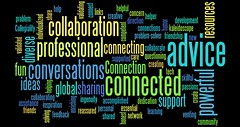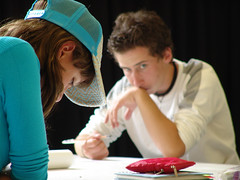Thirty years ago ISTE convened NECC with the same questions. What can we do to get people to use We need professinal development to help them get there.
What is the wall where teachers learn and where teacher teach? In workshops, in books, webinars, and yet what actually transfer ovet the wall into the classroom?
Community of Practice Research
The classrom is not a community of practice - how can we change that?
Tech Support
It is not just fixing hardware (all of it email, caeras, computers, and more) Fixing takes away from the time needed to learn. If you are fixing a problem, it is too late. Tech departments are now trying to mix tech support and tech integrators. Tech support is based on controlling and managing the hardware. Tech integrators are asking people to be resk takers, innovators, users of new programs and hardware. If they are working then there should probably be an upswing in the need for tech support.
Models of Professional DevelopmentUsing students as practitioners of technology. Teach students how to provide technology support for teachers. Why? Situated in their own classroom, models collaborative learning, allows students to play an important role provides support for technology use outside of formal professional development. Look at
GenYES as the example.
The assumption that there is not enough is incorrect.National Center for educational statistics 2000: Teachers said ther they were going
Stanford research Institiute 2002: 80% failure rate- teachers leaving professional development were leaving unable to implement the learning in their classrooms.
It is not lack of professional development but that the professional development is not working. Internationally Professional Development time internationally happens in the classrooms hours per day. They have a PLN ready to access within their schol.
Online professional development Schlager and Fusco reported that participants were more focused in discussing with their global friends, yet it was not going back to practice in the classroom.
Seymour Pappert - Teachers teach the way they were taught until they SEE something different. Tachers need the kind of activity where they are learning at the same time as the kids and with the kids. The culture of going away to learn something until you are perfect at it and then you can use it in the classrom
Classroom-embedded Professional Development We need professional developmen in our own classroom, modeled in other classrooms, peer-mentoring/coaching, reverse-mentoring, with experts all around.
It requres a Paradigm Shift- We have to talk about professional development to make it open, celebrate mistakes, collaborative, just-in-time, practice, process, constuctivist, inside the classroom.
Looking at the podcast video of CJ- He shows you all of the skills and the know how of how-to do a podcast. If you have a CJ (and everyone does) then why aren't we using them to teach and help teachers learn to use technology in their teaching.
GenYESA club of students headed by a lead teacher. The students are paired with teachers to create specific classroom lessons. The student and teachers plan, design and create. Students also learn collaborative skills to help them interact with their teachers. The research showed that 80-90% of the teachers who worked with the GenYES students said they would change the way they teach in the future. Who can say no to kids wanting to help out?
TechYESTeachers helping teachers get things done in their classroom. We don't all need to know everything. We can get help from each other. Develop experts in specific areas who will help others.
Constructivist Professional DevelopmentWalking the walk in your professional development is key. It takes time. You can't magic wand this into your classroom or district. Change desn't come with a checklist, it comes with hard work.
Elements
Authentic involvement
Trust/responsibiity
Real benefits for students
Adult guidance
Challenge and growth
Cycle of learner empowerment Begins with Empowerment- doing something authentic, and then follows with engagement, independence, responsibility, and trust.
 Image via Wikipedia
Image via Wikipedia![Reblog this post [with Zemanta]](http://img.zemanta.com/reblog_e.png?x-id=78dae253-250d-4993-b6cd-5f9b4c2a960b)

![Reblog this post [with Zemanta]](http://img.zemanta.com/reblog_e.png?x-id=7c10cad3-5b94-45af-b20c-3692f5553190)


![Reblog this post [with Zemanta]](http://img.zemanta.com/reblog_e.png?x-id=d36ee2ec-2174-4a49-8268-fd53ee815fa2)